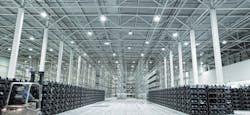Truckers take note: Demand for logistics space is soaring
Here’s a thought: amidst the good trends trucking is experiencing right now (rising tonnage, higher freight rates, the potential benefits from tax reform) and the not-so-good ones (the ongoing driver shortage, adjusting to new electronic logging device rules, the increasing cost of traffic congestion) a new problem may be coming into view: a tightening in the supply of logistics-focused real estate.
And it’s not just about the availability of warehouse and distribution space, nor the land needed to build such structures upon. Such facilities are also being rapidly automated, with complex – and costly – robots taking over the mundane packing, sorting, and storage jobs humans used to do. That may ultimately make the construction of warehouses and distribution centers more expensive.
And you can thank e-commerce – as usual – for this particular trend, according to Craig Meyer, president of the industrial group for real estate investment firm Jones Lang LaSalle Incorporated, which is more commonly known as JLL.
“E-commerce activity is really driving the industrial sector’s success,” he explained in a recent outlook brief. “It represents around 9% of total U.S. sales, and experts predict this could reach nearly 14% in the coming years. Those figures, along with a strong global economy, indicate that demand for industrial space will only increase in 2018.”
Meyer added that, warehouses and distribution centers were once considered the “ugly ducklings” of commercial real estate. Now they are emerging as “beautiful swans” for both real estate investors and corporate occupiers as low vacancy rates and high demand for warehouse space are forming what he dubbed “perfect conditions” for the logistics real estate sector in 2018.
Here are four other factors JLL thinks will further accelerate demand for logistics-focused real estate:
- The three Ts of Trump – Trade, Tax and Transportation infrastructure. While there is no evidence of an overt strategy coming from the White House, the dominos seem to be falling in a way that suggest 2018 could be the year for major infrastructure legislation. Trade agreements are being renegotiated and tax reform is now completed, so the doors could open to address infrastructure. The urbanization of U.S. cities cannot continue with functionally obsolete roads, bridges and other infrastructure. As upgrades are planned, raw materials will be needed and warehouses to store them.
- E-commerce continues to set records. Online shopping and consumer demand for rapid delivery is changing the “what, where and how” of logistics – and many distribution centers are needed to feed the consumer e-commerce beast. E-commerce continues to be a fast-growing sector: In the third quarter alone, nearly 25% of total U.S. leasing demand came from e-commerce companies expanding their existing market footprints.
- Urban logistics move closer to the customer. In a bid to narrow the gap with brick and mortar stores, e-commerce and its related logistics companies are looking to accelerate their investment in “last-mile” warehouse spaces. Global and domestic tenants are expanding their presence beyond a single mega-warehouse facility to multiple U.S. nodes, using logistics space to extend their reach to connect with customers. At the same time, distribution models are changing and location strategy is more focused on proximity to labor and customers. As e-commerce operations mature, tenants will seek smaller distribution centers closer to urban cores, but finding the right location will become challenging.
- The Fourth Industrial Revolution is well underway. The robots aren’t coming—they are already here. Human-free warehouses are a long way off, but sophisticated automation is becoming a feature of today’s industrial buildings. It’s already possible to offload goods from a truck, put them on a pallet, and then onto a different truck with barely a helping hand from a human being. At the same time, drones equipped with sensors can now scan bar codes for inventory purposes, safely restock and pick merchandise on high shelves, and move small items quickly around the warehouse. Automation within the warehouse is an important emerging trend that will continue to develop. This will reshape how warehouses are designed and how they are used.
“These factors and smart infrastructure investment could nurture economic growth, which is especially needed in cities and states that have lost economic momentum with the decline of manufacturing,” noted Walter Kemmsies, managing director, economist and chief strategist at JLL’s port, airport and global infrastructure (PAGI) group.
“Investing in export-related infrastructure is also critical to balance trade deficits and would especially benefit agriculture, capital goods and energy, which are the most competitive sectors of the U.S. economy,” he said. “This could further boost the industrial real estate sector.”
We’ll soon see how that trend develops, for 2018 is just around the corner.
About the Author
Sean Kilcarr
Editor in Chief
Sean Kilcarr is a former longtime FleetOwner senior editor who wrote for the publication from 2000 to 2018. He served as editor-in-chief from 2017 to 2018.
